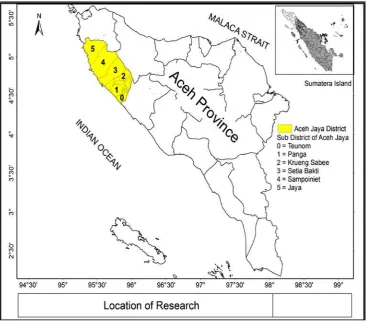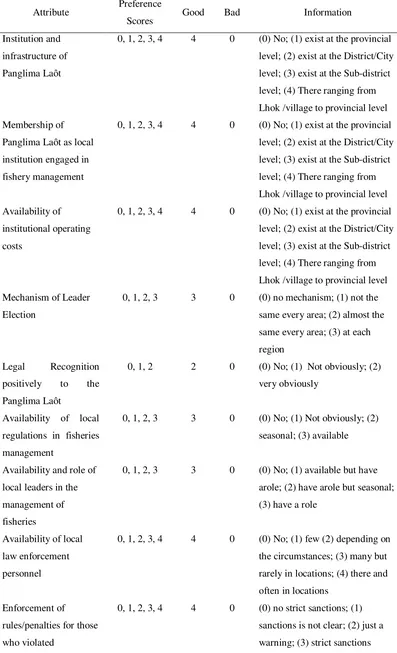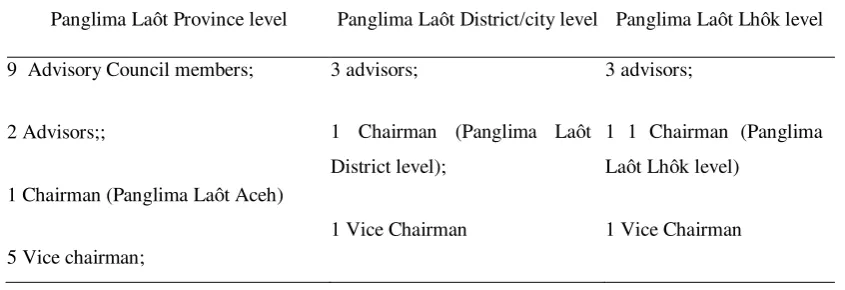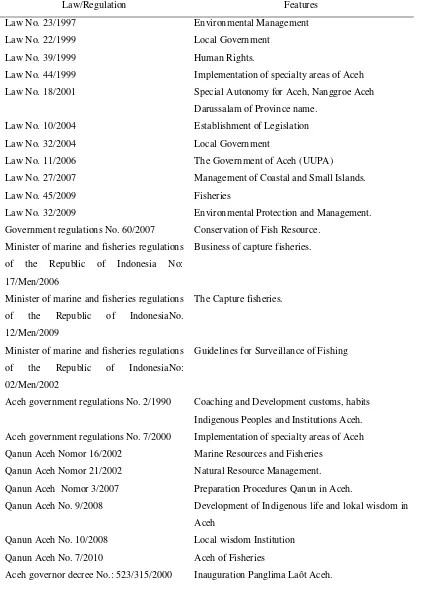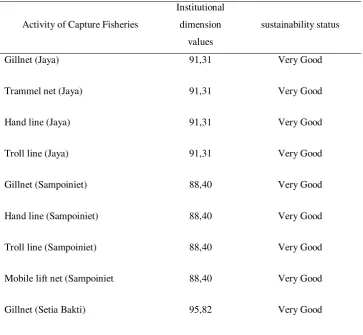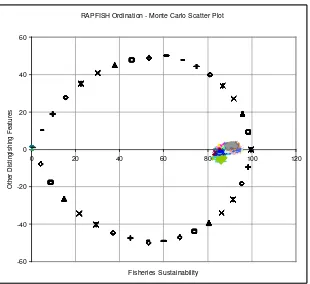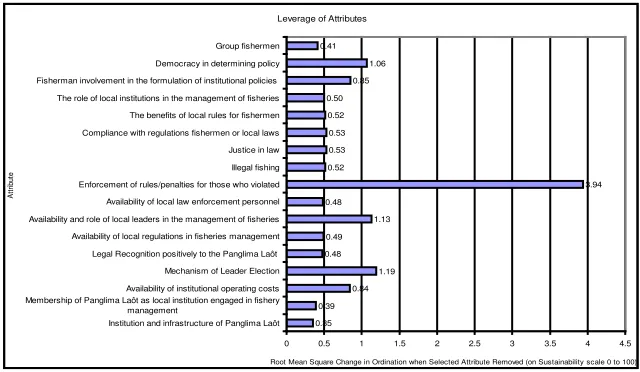Basic and Applied Research
(IJSBAR)
I SSN 2 3 0 7 - 4 5 3 1 (Print & Online)
http://gssrr.org/index.php?journal=JournalOfBasicAndApplied
---
Institution of Panglima Laôt in Supporting Sustainable
Capture Fisheries Based on Local Wisdom in Aceh Jaya
District
Chaliluddin
a*, Ari Purbayanto
b, Daniel R. Monintja
c,
Mohammad Imron
d, Joko Santoso
ea
Faculty of Marine and Fisheries , Syiah Kuala University, Banda Aceh
b , c , d
Department of Fisheries Resource Utilization, Faculty of Fisheries and Marine Sciences, Bogor
Agricultural University.
e
Department of Aquatic Product Technology, Faculty of Fisheries and Marine Sciences, Bogor
Agricultural University.
a
b
c
d
e
Abstract
This research has been conducted at six sub-districts namely Jaya, Sampoiniet, Setia Bakti, Krueng Sabee,
Panga and Teunom in Aceh Jaya district, Aceh Province, Indonesia from September 2012 to February 2013.
Study aimed to determine the sustainability status of catching fisheries based on local wisdom in Aceh Jaya
district in perspective of institutional dimensions. The methods used were the literature study and survey method
by using questionnaires.
---
* Corresponding author.
E-mail address: [email protected].
Data and information were analyzed using the technique of RAPFISH (Rapid Appraisal of the status of
Fisheries), in which samples consisted of 117 respondents with 24 fishing activities selected by purposive
sampling for being interviewed. The results showed that the institutional dimension of sustainability status of
catching fisheries based on local wisdom in Aceh Jaya district has sustainability index values between 88.32 to
95.82 (in status category of excellent or very sustainable). The attributes that were very influential in
determining the sustainability index values were the attributes of law enforcement or sanctions for fishermen
who broke the law. In the development, it was needed strict punishment from personal of local law enforcement
that they had agreed upon for generations as well as efforts to preserve the values of local wisdom that has
existed.
Keywords: institutional; Panglima Laôt; fisheries sustainability; local wisdom; Aceh Jaya
1. Introduction
Utilization of fish resources in the field of fisheries requires strong institutional governance as part of the
resource management of sustainable fisheries. Institutional management is directed not only to fish resources as
the utilization target but also to fisheries stakeholders, namely human resources and institutions [1].
Administratively, the province of Aceh in general and Aceh Jaya district in particular besides Department of
Marine and Fisheries, there has also been already formal institution that manages fisheries namely Panglima
Laôt. Panglima Laôt is the oldest traditional institution in the world in terms of local wisdom-based management
of fisheries. This fisherman institution has played an important role in regulating the fishery industry in Aceh
for more than four centuries. Panglima Laôt is as indigenous or local wisdom stakeholder, of which formation
is guaranteed by law both positive laws and local regulations known as Qanun Aceh. Some rules regarding the
recognition of the existence of positive law to local wisdom relating to the management of fisheries resources in
Aceh are as follows; Law No. 31/2004 [2] on Fisheries, Article 52 says "The government set up, encourage,
and/or conduct fishery research and development to produce the required knowledge and technology in the
development of fishing effort to be more effective, efficient, economical, powerful competitive, and
environmentally friendly, as well as appreciate the local wisdom." Qonun Aceh No. 16/2002 [3] on the
Management of Marine Resources and Fisheries, article 11 paragraph 2 says "In the management of fishery
resources, the provincial government recognizes the existence of Panglima Laôt institution and customary laws
that have been existed in the lives of fishing communities in Aceh province."
Based on the article explained above, the Government of Aceh gives recognition to the existence of Panglima
Laôt which is customary law institution that plays an important role in managing fishing activities in Aceh. This
is reinforced by Qanun Aceh No. 10/2008 [4] on Indigenous Institution in which article 2 paragraph 2
sub-paragraph i says "Indigenous institutions serve as a vehicle for public participation in governance, development,
community development, and resolution of social problems."
Panglima Laôt is also defined as a person who leads the customs, habits prevailing in the field of marine
fisheries and settlement of disputes (Article 1 (13) Regulation No. 7/2000) [5]. Regulation No. 7 of 2000,
Section 1, paragraph (18), "Indigenous customary law is Acehnese live and thrive in the community in the
Region". In article 1 paragraph 19, "...is a custom rule or act based on prevalent Islamic law obeyed, respected,
venerated since ancient and serve as the foundation of life". Article 1, paragraph 20, " Habits is an activity or
action that basically is not derived from customary law or customs but it has been recognized by the public and
has been carried out repeatedly and continuous". In article 1 paragraph 12 of Aceh Qanun No. 21/2002 [6] on
the Management of Natural Resources, it is found the term “indigenous peoples” is a group of people who live
in a certain area for generations and they are based on the similarity residence or blood relationship which has
own indigenous territories and indigenous institutions." Article 1, paragraph 8 of Aceh Qanun No. 4 of 2003 [7]
of Mukim, says, “Customary law is all custom rules, customs and habits of the people living in Aceh, which has
binding and legal consequences". In article 1, paragraph 11, 12 and 13 of Aceh Qanun No. 9 of 2008 [8] on the
fostering of indigenous life and customs, says, "Customary law is a set of unwritten provision that lives and
thrives in Acehnese society, which has the sanction if it is violated". "Customs is eternal and behavior patterns
passed down from generation predecessors are honored and glorified as inheritance according to Islamic law".
“Habit is the attitude and actions are performed repeatedly for the same thing, which is alive and growing and
implemented by the community".
Article 1 (29), (30), and (31) of Aceh Qanun No. 10/2008 concerns about the indigenous institution. In the
Aceh Qanun, "Panglima Laôt or any other name is a person who leads and arranges customs in coastal and
marine areas".
Thus all the rules and customary law (value-the value of local knowledge) related to fisheries must be executed
by the Panglima Laôt, the problem is in compliance with these rules. This issue becomes very interesting
because of regulations governing the management of the environmental impact of fisheries resources [9] in
addition to the national character set in the context of the global as well as introduced by world bodies such as
the FAO. FAO has made rules about utilization of fishery resources, both capture fisheries and aquaculture,
known as the Code of Conduct for Responsible Fisheries (CCRF) whose goal is to make the code of conduct of
responsible fisheries development in 1995.
Institutional sustainability is a prerequisite for the other three components of sustainability, namely ecological
sustainability, economic sustainability, and technological and socio-cultural sustainability, involving the
maintenance of appropriate financial and organizational capabilities and long-term administration. In particular,
institutional sustainability refers to the law/rules governing fisheries management organizations with tools of
those implements [1, 10, and 11]. Therefore, it is necessary to study to measure the sustainability of fisheries on
the institutional dimensions, in order to determine the effect and the role of Panglima Laôt in achieving
institutional sustainability of fisheries based on local wisdom in Aceh in general and Aceh Jaya in particular.
The purpose of this study was to determine the sustainability status of capture fisheries based on local wisdom
in Aceh Jaya district on institutional dimensions.
2. Methods
The research was conducted from September 2012 to February 2013 in the Aceh Jaya district, Aceh Province,
Indonesia, including Jaya, Sampoiniet, Setia Bakti, Krueng Sabee, Panga and Teunom sub-districts (Figure 1).
The study was conducted using a literature review and survey method. The data collected were in the form of
primary and secondary data. The primary data were obtained through interviews with respondents. The
respondent were the fishermen who used certain fishing gears such as purse seine, mobile liftnet, hand line, troll
line, gillnet and trammel net. Each group of fishing gear consisted of 5 (five) people each in each sub-district in
Aceh Jaya, thus totaling 117 respondents specified by purposive sampling with the consideration that the
respondent is fisheries. Secondary data were obtained from the relevant authorities, such as the Panglima Laôt
of Aceh Institution, Department of Marine and Fisheries and report research results.
The analytical method used in evaluating the sustainability of fisheries based on local wisdom in Aceh Jaya
district was RAPFISH (Rapid Appraisal for the status of Fisheries), which was an analysis technique to evaluate
the sustainability of fisheries in multidisciplinary [1,11,12].
Figure 1. Map of research sites (Aceh Jaya District)
The application of Rapfish approach in this study was based on the identification of fishing activities at the sites.
This activity resulted in the identification of types of fishing gears used namely purse-seine, gillnet, trammel net,
mobile liftnet, troll line, hand line and mini long line, in the utilization of fish resources in the 6 sub-districts at
Aceh Jaya. Determination of the institutional dimension attributes (Table 1) was prepared [1, 13, 14, 15, and 16]
based on the values of local wisdom.
Table 1. Attribute of sustainability and institutional dimensions the scoring criteria
Attribute Preference
Scores Good Bad Information
Institution and
infrastructure of
Panglima Laôt
0, 1, 2, 3, 4 4 0 (0) No; (1) exist at the provincial
level; (2) exist at the District/City
level; (3) exist at the Sub-district
level; (4) There ranging from
Lhok /village to provincial level
Membership of
Panglima Laôt as local
institution engaged in
fishery management
0, 1, 2, 3, 4 4 0 (0) No; (1) exist at the provincial
level; (2) exist at the District/City
level; (3) exist at the Sub-district
level; (4) There ranging from
Lhok /village to provincial level
Availability of
institutional operating
costs
0, 1, 2, 3, 4 4 0 (0) No; (1) exist at the provincial
level; (2) exist at the District/City
level; (3) exist at the Sub-district
level; (4) There ranging from
Lhok /village to provincial level
Mechanism of Leader
Election
0, 1, 2, 3 3 0 (0) no mechanism; (1) not the
same every area; (2) almost the
same every area; (3) at each
arole; (2) have arole but seasonal;
(3) have a role
Availability of local
law enforcement
personnel
0, 1, 2, 3, 4 4 0 (0) No; (1) few (2) depending on
the circumstances; (3) many but
rarely in locations; (4) there and
often in locations
Enforcement of
rules/penalties for those
who violated
0, 1, 2, 3, 4 4 0 (0) no strict sanctions; (1)
sanctions is not clear; (2) just a
warning; (3) strict sanctions
Illegal fishing 0, 1, 2 0 2 (0) No, Never; (1) sometimes; (2)
every so often
Justice in law 0, 1, 2, 3, 4 4 0 (0) Very unfair; (1) Unfair; (2)
fair sometimes; (3) depending on
the circumstances; (4) very fair
Compliance with
regulations fishermen
or local laws
0, 1, 2, 3 3 0 (0) not Complying; (1) obedient if
any officers in the field (2)
sometimes obedient (3) very
obedient even though no officer
The benefits of local
rules for fishermen
0, 1, 2, 3 3 0 (0) do not know; (1) No; (2) little
benefit; (3) so many benefits
The role of local
institutions in the
management of
fisheries
0, 1, 2 2 0 (0) no role; (1) No, but there is no
role; (2) yes very role
Fisherman involvement
in the formulation of
institutional policies
0, 1, 2, 3 3 0 (0) 5 - 20 %; (1) 20 - 50 %; (2) 50
- 75%; (3) > 75%
Democracy in
determining policy
0, 1, 2, 3 3 0 (0) Not obviously; (1) no
democracy; (2) little democracy;
(3) very democracy
Group fishermen 0, 1, 2, 3 3 0 (0) no; (1) yes but not active; (2)
seasonal; (3) yes there is and it
works fine
After arranging the attributes, then arrange the assessment criteria (Table 2). Attributes on the dimensions and
criteria of good and bad [11 and 17], as well as the opinions of experts and stakeholders associated with the
system being studied.
Each attribute was estimated its score, of which maximum score was 4 for good category, 0 for bad category and
the state of category between good and bad. Score is the definitive value, which is analyzed to determine the
points that reflect the sustainability of the relative system to the position of the good and bad points with MDS
ordination technique. The score of each dimension is expressed by the scale of the worst 0 % until the best 100
%.
3. Results and Discussion
3.1 Institutional Panglima Laot in attribute of Rapfish
Preparation of scores on the dimensions of institutional sustainability status of fisheries based on local wisdom
was based on the state of research and field areas based on the reference of the criteria that have been made,
then analyzed as facts or data in the attribute of Rapfish reality.
Table 2. Categories of index each dimension of sustainability
Index Value Valuation Category Sustainability
0 – 19 Bad Not Sustainable
20 – 39 Enough Less of Sustainable
40 – 59 Moderate Sustained moderate
60 – 79 Good Sustainable
80 – 100 Very good Very Sustainable
3.1.1 Institution and infrastructure of Panglima Laôt
Traditional institution of Panglima Laôt is an institution that supports fishing activities in Aceh. Panglima Laôt
as an institution has an institutional structure to carry out its functions and duties. Panglima Laôt institutional
structure [18] in Aceh consists of 3 levels namely: (1) Panglima Laôt of Province; (2) Panglima Laôt of
district/city and (3) Panglima Laôt of Lhok (Table 3). Institutional structures owned by the three levels of
Panglima Laôt institutions are different, because the higher position will have the more complex institutional
structure. All levels of these Panglima Laôt have places as secretariats.
3.1.2 Membership of Panglima Laôt as local institution engaged in fishery management.
The membership of Panglima Laôt includes the entire of Aceh fishing community, academics, legal
practitioners and other stakeholders who want to promote fisheries in Aceh.
3.1.3 Availability of institutional operating costs
As a large organization of all fisherman house of Aceh, the Panglima Laôt also needs institutional cost (budget)
in its operational work. At the first time, institution of Panglima Laôt did not have operating budget, and the
personnel involved in this institution dedicated solely to the community without expecting any compensation.
Now, Panglima Laôt institution has budget (fund) approximately in amount of Rp. 60,000,000,000,- (sixty
billion rupiahs) which was derived from the results of the auction of fishing boats and fishing gears owned by
Thai fishermen who were arrested by Aceh fishermen at fishing operation in Aceh waters because of illegal
fishing, and the grants from Coordinating Minister for People's Welfare of Republic of Indonesia. The budget
has been used as an institutional endowment of Aceh Panglima Laôt.
Table 3. Structure of Institutional Panglima Laôt at Provincial level until Panglima Laôt Lhok/village
Panglima Laôt Province level Panglima Laôt District/city level Panglima Laôt Lhôk level
9 Advisory Council members;
2 Advisors;;
1 Chairman (Panglima Laôt Aceh)
5 Vice chairman;
3 advisors;
1 Chairman (Panglima Laôt
District level);
1 Vice Chairman
3 advisors;
1 1 Chairman (Panglima
Laôt Lhôk level)
1 Vice Chairman
3.1.4 Mechanism of Leader Election
During the Islamic Kingdom of Aceh “Samudra Pasei” led by Sultan Iskandar Muda, Panglima Laôt was
appointed by the king who was an representative of Sultan Iskandar Muda [19], whose role is to collect taxes
from merchant ships in the harbor and to mobilize the masses in the war. However, at the present time,
Panglima Laôt is elected directly by the fishing master who has the right to vote, and the election Panglima Laôt
is done no more than 3 years. The requirements of being Panglima Laôt are Indonesian citizen, male, maximum
age of 55 years, minimum education of graduating elementary school or being able to write and read, having
experiences in the field of fishing, and understanding Laôt customary law (the value of local wisdom).
Mechanism Assembly election is conducted by the Great of Panglima Laôt subsequently confirmed in a decree
for the stewardship of the Provincial and Regent/Mayor for District/City.
3.1.5 Legal Recognition positively to the Panglima Laôt
Laôt customary law or local wisdom has been around a long time in Aceh and continues to grow along with the
growth of indigenous culture fishermen in Aceh. Laôt customary law or local wisdom remains adhered to
without any coercion and executed in accordance with the cultural values, customary norms in accordance with
Islamic law by indigenous fishermen in Aceh. Laôt local wisdom in Aceh is recognized by positive law, which
is applicable law in Indonesia. Some rules regarding the legal recognitions of positive law (Table 4) to the
existence of Laôt customary law or local wisdom relating to the management of fisheries resources in Aceh are
shown in table 4.
3.1.6 Availability of local regulations in fisheries management
The availability of these local regulations is established by the Panglima Laôt by agreement of the fishing
communities. Local Regulation was formed because of the need of fishing community for clarity of
management of fishery resources. Local rules in the management of fishery resources agreed by fishermen in
Aceh Jaya are the prohibition of fishing on certain days, the existence of customary rules in the maintenance of
coastal and marine environment, and the presence of the zoning arrangement in the fishing business. Thus it can
be said that the overall regulatory Panglima Laôt for fishery sustainability has been existed in Aceh Jaya district.
Table 4. Several laws and regulations issued by the government of the Republic of Indonesia and the Aceh
government relating to the management of fisheries resources
Law/Regulation Features
Law No. 23/1997 Environmental Management
Law No. 22/1999 Local Government
Law No. 39/1999 Human Rights.
Law No. 44/1999 Implementation of specialty areas of Aceh
Law No. 18/2001 Special Autonomy for Aceh, Nanggroe Aceh
Darussalam of Province name.
Law No. 10/2004 Establishment of Legislation
Law No. 32/2004 Local Government
Law No. 11/2006 The Government of Aceh (UUPA)
Law No. 27/2007 Management of Coastal and Small Islands.
Law No. 45/2009 Fisheries
Law No. 32/2009 Environmental Protection and Management.
Government regulations No. 60/2007 Conservation of Fish Resource.
Minister of marine and fisheries regulations
of the Republic of Indonesia No:
17/Men/2006
Business of capture fisheries.
Minister of marine and fisheries regulations
of the Republic of IndonesiaNo.
12/Men/2009
The Capture fisheries.
Minister of marine and fisheries regulations
of the Republic of IndonesiaNo:
02/Men/2002
Guidelines for Surveillance of Fishing
Aceh government regulations No. 2/1990 Coaching and Development customs, habits
Indigenous Peoples and Institutions Aceh.
Aceh government regulations No. 7/2000 Implementation of specialty areas of Aceh
Qanun Aceh Nomor 16/2002 Marine Resources and Fisheries
Qanun Aceh Nomor 21/2002 Natural Resource Management.
Qanun Aceh Nomor 3/2007 Preparation Procedures Qanun in Aceh.
Qanun Aceh No. 9/2008 Development of Indigenous life and lokal wisdom in
Aceh
Qanun Aceh No. 10/2008 Local wisdom Institution
Qanun Aceh No. 7/2010 Aceh of Fisheries
Aceh governor decree No.: 523/315/2000 Inauguration Panglima Laôt Aceh.
Aceh governor decree: 523.11/012/2005 Inauguration Panglima Laôt Aceh.
regent decrees of Aceh Jaya No. 3/2010 Establishment of Protected Areas in Aceh Jaya
District
3.1.7 Availability and role of local leaders in the management of fisheries
The availability and the role of local community leaders who truly been and can be trusted by local fishermen is
necessary given the diversity of perceptions of fishers in fisheries management in general. The role of leaders is
very important, especially to handle the social problems of illegal fishing by fishermen outside of Aceh, and the
event of a conflict between the fishermen. The role of the fishermen community leaders Aceh Jaya is highly
visible in various aspects of social life including in protecting the fishing environment and the local fishing
waters from destructive activities performed by both local fishermen and outsiders.
3.1.8 Availability of local law enforcement personnel
According to interviews conducted with respondents, it can be stated that, law enforcement personnel and local
rules always exist, if not when the case occurs, fishermen who saw the case can report the incident to the local
Panglima Laôt and the case will be processed in the court by law enforcement agencies and Panglima Laôt, and
if the case cannot be resolved by the local Panglima Laôt it will be reported to the law enforcement authorities
of the Republic of Indonesia (in this case, the police).
3.1.9 Enforcement of rules/penalties for those who violated
Results of interviews with fishermen in Aceh Jaya district, all respondents stated that in Aceh Jaya district,
conflicts with fishermen have never occurred, and infringement of prohibited law by institution of Panglima
Laôt has never occurred, because according to the respondents, if the violation occurred, legal sanctions or
penalties will firmly applied for anyone who violated.
3.1.10 Illegal fishing
Fishing activities in the waters of Aceh Jaya are done generally by local fishermen of Aceh and there is no
indication of illegal fishing done by local fishermen, both violations of fishing area and type of fishing gear. If
there is illegal fishing in the waters of Aceh Jaya, it is usually done by outsider of Aceh fishermen (fishermen
from North Sumatra and Fishermen Thailand).
3.1.11 Justice in law
Fairness in this law can be understood as justice in resolving the problem or case law by law enforcement
officers, either from the police or private parties and local law enforcement in order to utilize the fish resources.
So far, the role of law enforcement in dealing with fisheries has been running very well and very fair.
3.1.12 Compliance with regulations fishermen or local laws
So far in the management of fishery resources, the regulations are issued by both the formal institutions of the
central government and the Aceh government for sustainable fishing activities. However, the implementation on
the field, there is sometimes no supervision in practice so that the implementation is neglected. According to
interviews with respondents, all fishermen in Aceh Jaya district comply with the regulations, both national laws
and regulations set by the institution of Panglima Laôt.
3.1.13 The benefits of local rules for fishermen
Based on interviews with respondents, they state that the rules made by the Panglima Laôt are excellent for the
preservation of the environment and fish resources and support fishermen. All rules issued by agencies of
Panglima Laôt are always followed by fishing communities because these rules have been implemented from
generation to generation.
3.1.14 The role of local institutions in the management of fisheries
Institution of Panglima Laôt strongly supports the management of fishery resources in Aceh and plays an
important role in the sustainability of fisheries. This institution was formed because of the needs of the fishing
community as a manifestation of the desire of the fishermen themselves who are worrying to the decline in
aquatic environment and also for sustainability of fish resources.
3.1.15 Fisherman involvement in the formulation of institutional policies
Determination of marine and fisheries development policy in general and in particular Aceh Aceh Jaya
conducted by Panglima Laôt has involved the direct role of fishing communities. Determination and policy
formulation of Panglima Laôt are always done with sharing opinion or discussion of Great Panglima Laôt
followed by any representative of Panglima Laôt on each level. Policy formulation is always issued with a result
that is binding on all parties and it is expressed in the Decree. Questionaire results are distributed to the
respondents, all of them chose number two (2) which means that the institutional policy formulation of
Panglima Laôt always involves fishing communities.
1.3.16 Democracy in determining policy
Determination of marine and fisheries development policy in Aceh Jaya always involve direct opinion Panglima
Laôt of Aceh Jaya which is indigenous stakeholders who runs the values of indigenous fishing communities.
The interviews with the head of the Department of Marine and Fisheries Aceh Jaya and Aceh Jaya Panglima
Laôt, almost in every work program of Department of Marine and Fisheries Aceh Jaya District involves
Panglima Laôt of Aceh Jaya, so that information and development programs initiated by the local government
are quickly accepted by the fishing community. So the fishermen felt that the determination of policy was very
democratic.
1.3.17 Group fishermen
The support group of fishermen are fishing group involvement in supporting the sustainability of fishing
activities based on local wisdom, in the form of group activity fishermen, fishing groups support programs in
fisheries sustainability which shows a strong correlation between fishing group support and the sustainability of
catching fisheries.
According to an interview with the Department of Marine and Fisheries Aceh Jaya, Aceh Jaya fishermen have
already formed many groups of fishermen. Fishing groups are formed in rehabilitation and reconstruction after
Tsunami attacked Aceh, so that running programs and development of marine fisheries in Aceh Jaya is very
easy, especially in terms of the distribution of aid fishing boats and fishing gears.
3.2 Status of fisheries sustainability based on local wisdom of institutional dimension
Value contained in the dimension scores was then analyzed using method of institutional RAPFISH. The output
obtained by the method indicates that RAPFISH on institutional dimensions of fisheries sustainability index
values based on local wisdom as presented in Table 5. This value will determine the relative position of each of
the ordination of fishing activities that are in the good range with a value of 100, and bad with a value of zero.
Table 5. The Value dimensions of the institutional sustainability of fisheries based on local wisdom in Aceh
Jaya District
Activity of Capture Fisheries
Trammel net (Setia Bakti)
Handline (Setia Bakti)
Troll line (Setia Bakti)
Mobile lift net (setia Bakti)
Purse seine (Krueng Sabee)
If the value of the institutional dimension in Table 5, over in Plot in Figure ordinance, it will appear as seen
Figure 2.
Figure 2. The Ordinated institutional of fisheries dimensions based on local wisdom in Aceh Jaya District
Analysis of the ordinance in the institutional dimension of the number of iterations for three (3) times, produced
a value squared correlation (R2) of 97.26 percent and the value of stress (S) equal to 11.80 percent. Thus, the
institutional dimension analysis in this study indicates the good condition or goodness of fit of which the stress
value obtained is less than 25 percent.
While the results of Monte-Carlo analysis and Leverage were conducted to determine the uncertainty aspects
and anomalies of the attributes analyzed (Figure 3). Fishing activities in Aceh Jaya district has excellent
sustainability status (very sustainable), it is seen from the value dimensions (Table 5) with range from 88.32 to
95.82. The coefficient of determination (R2) is equal to 97.26 percent and 11.80 percent of the value of stress.
To evaluate the impact of random error was conducted the ordinance stability analysis with Monte Carlo
simulation method which was conducted on all dimensions [11 and 12]. There are three types to perform Monte
Carlo algorithm. In this study, it was only analysis of the Monte Carlo method "scatter plot" that shows the
ordination of any dimension. Analysis of the results in view of the stability of the ordinance was done to see the
level of disturbance (perturbation) of the value of ordination [20], which was carried in 25 times iteration.
RAPFISH Ordination - Monte Carlo Scatter Plot
-60
Figure 3. Monte-Carlo results of the analysis of the institutional dimension of fisheries based on local wisdom in
Aceh Jaya District
Leverage analysis results against indicators that are used in the institutional dimension (Figure 4) showed the
highest value of 3.94 on the attributes of law enforcement/sanctions for noncompliance and the lowest value of
0.35 for the attribute group of fishermen. Leverage analysis results are used for all the attributes in the
institutional dimension.
Sustainability status of fisheries based on local wisdom in Aceh Jaya district with Rapfish technique was done
through several stages and perspective analysis related institutional dimension of Panglima Laôt in Aceh Jaya
district. These stages include (1) an inventory of the regulations related to fisheries, including their
implementation, and the role of institutions in sustainable fisheries development efforts, which is done by
comparing a collection of documentation and observation of actual conditions in the field (2) determination of
the sustainability index scores and, (3) depiction Rapfish ordinance institutional dimension, (4) test of goodness
of fit with the procedure of multidimensional scaling (MDS), (5) determination of the coefficient of
determination (R2), (6) stability test ordinance with Monte Carlo analysis techniques, (7) sensitivity test with
leverage analysis method, (8) attribute of sensitive portrayal institutional dimension and (9) the determination of
the response (the implications of alternative policy) to sensitive attributes [11].
Leverage of Attributes
Institution and infrastructure of Panglima Laôt Membership of Panglima Laôt as local institution engaged in fishery
management
Availability of institutional operating costs Mechanism of Leader Election Legal Recognition positively to the Panglima Laôt Availability of local regulations in fisheries management Availability and role of local leaders in the management of fisheries Availability of local law enforcement personnel Enforcement of rules/penalties for those who violated Illegal fishing Justice in law Compliance with regulations fishermen or local laws The benefits of local rules for fishermen The role of local institutions in the management of fisheries Fisherman involvement in the formulation of institutional policies Democracy in determining policy
Root Mean Square Change in Ordination when Selected Attribute Removed (on Sustainability scale 0 to 100)
Figure 4. Results of the analysis of the institutional dimension Leverage based on local wisdom in Aceh Jaya
district
Based on the results of the sensitivity analysis with leverage (Figure 4), it indicates that the law
enforcement/sanctions for noncompliance [21], is an attribute that greatly affects the value or sustainability
status of fisheries in Aceh Jaya. Lack of respect for the values of local or indigenous knowledge can be assumed
that the fishermen have not fully complied with the rule of law and selfish [22]. Root mean square change value
of the attribute of law enforcement/sanctions for noncompliance is much higher than other attributes. Law
enforcement/sanctions for noncompliance in fisheries sustainability has become very necessary because the
legal consequences of institution in realizing a law enforcement [23]. Sustainability of fisheries system based
on local wisdom is highly dependent on the institutional values in maintaining socio-ecological and ecosystem
function [24]. A socio-ecological system consists of units of bio-geophysical and social actors and the
institutions associated with it. Social-ecological systems are complex, adaptive and constrained by the limits of
spatial or functional institutions that surround the institutions [25]. Sustainability also requires equal access to
good quality of life, including obeying the law and impose sanctions for noncompliance, material, social and
emotional well-being. Welfare is a holistic concept combining human connectedness with the law and its
institutions were included [10].
4. Conclusions
Status of the institutional dimensions of sustainability in capture fisheries based on local wisdom in Aceh Jaya
district has excellent sustainability index score based on each of the existing fishing activities in Aceh Jaya
district with sustainability values between 88.32 to 95.82 (status excellent/very sustainable).
Attributes that highly influential in determining the sustainability index value are the attribute of the law
enforcement/sanctions for noncompliance. The development is likely to be done through a policy aimed at
improvement of the quality attributes of the sustainability of fisheries policy improvement without discouraging
other attributes within the institutional dimension.
Reference
[1] AT.Charles. Sustainable Fishery Systems. Blackwell Sciences. London. UK. 2001. pp. 185-221
[2] Undang-Undang No. 32/2004 tentang Pemerintah Daerah. Jakarta. Indonesia. pp 1-159 [October 15, 2004].
[3] Qanun Aceh Nomor 16/2002 tentang Sumberdaya Kelautan dan Perikanan. Banda Aceh. Indonesia. pp 1-12
[October 14, 2002].
[4] Qanun Aceh Nomor 10/2008 tentang Lembaga Adat. Banda Aceh. Indonesia. pp 1-16 [December 30, 2008].
[5] Perda Aceh Nomor 7/2000 tentang Penyelenggaraan PenyelenggaraanKehidupanAdat. Banda Aceh.
Indonesia. pp 1-10 [July 25, 2000].
[6] Qanun Aceh Nomor 21/2002 tentang Pengelolaan Sumberdaya Alam. Banda Aceh. Indonesia. pp 1-16
[October 14, 2002].
[7] Qanun Aceh Nomor 4 Tahun 2003 tentang Pemerintahan Mukim dalam Provinsi Nanggroe Aceh
Darussalam. Banda Aceh. Indonesia. pp 1-8 [July 15, 2003].
[8] Qanun Nomor 9 Tahun 2008 tentang Pembinaan Kehidupan Adat dan Adat-Istiadat. Banda Aceh. Indonesia.
pp 1-10 [December 30, 2008].
[9] Aarras N, Rönkä M, Kamppinen M, Tolvanen H, Vihervaara P. “Environmental technology and regional
sustainability –The role of life-based design”. Journal of Technology in Society 36 (2014) 52–59 [December 5,
2013].
[10] Jordan SJ, Hayes SE, Yoskowitz D, Smith LM, Summers JK, Russell M. Accounting for natural resources
and environmental sustainability: linking ecosystem services to human well-being. Journal of Environment
Science Technology 44(5):1530–1536. 2010 [ September 16, 2009]
[11] TJ. Pitcher and D. Preikshot. “Rapfish, A Rapid Appraisal Technique For Fisheries, And Its Application To
The Code Of Conduct For Responsible Fisheries”. Journal of Fisheries Research 49 (2001): 255-270. [April11,
2000].
[12] A. Fauzi, dan S. Anna. “Pemodelan sumberdaya perikanan dan kelautan. Untuk analisis kebijakan”. PT.
Gramedia Pustaka Utama. Jakarta 2005. pp. 265 -288.
[13] T.T. Hartono, T. Kodiran, M.A. Iqbal dan S. Koeshendrajana. “Pengembangan Teknik Rapid Appraisal For
Fisheries (Rapfish) Untuk Penentuan Indikator Kinerja Perikanan Tangkap Berkelanjutan di Indonesia”.
Buletin Ekonomi Perikanan 6(1):65-76. 2005.
[14] RAPFISH Group. “Standard Attributes For Rapfish Analyses Evaluation Fields For Ecological,
Technological, Economic, Social And Ethical Status”. Fisheries Centre, UBC. Vancouver. 2006.
[15] B.O. Nababan, Sari Y.D dan M. Hermawan. “Analisis keberlanjutan perikanan Tangkap Skala Kecil Di
Kabupaten Tegal Jawa Tengah”. Jurnal Kebijakan dan Riset Sosial ekonomi 2(2):137-157. 2007
[16] R.M. Abdullah, S.H. Wisudo, R.D. Monintja, dan M.F.A. Sondita. “Keberlanjutan Perikanan Tangkap di
Kota Ternate pada Dimensi Ekologi”. Bulletin PSP XIX (1) 115 – 128. 2011.
[17] M.S. Allahyari. “Social sustainability assessment of fisheries cooperative in guilan province, Iran”. Journal
of Fisheries and Aquatic Science 5(3): 216-222. 2010.
[18] M.A. Abdullah, Sulaiman, dan T. Muttaqin. “Selama kearifan adalah kekayaan. Eksistensi Panglima Laot
dan Hukom adat laot Aceh”. Yayasan keanekaragaman hayati Indonesia. Jakarta. 2006. pp. 45 – 88.
[19] S. Daud dan M.C. Adek. “Adat meulaôt (adat menangkap ikan di laut)”. CV. Boebon Jaya. Banda Aceh –
Indonesia. 2010. pp. 8 – 56.
[20] I. Spence and F.W. Young. “Monte Carlo Studies in Nonmetric Scaling”. Phycometrica. 43(1) : 75-89.
1978.
[21] Sillitoe P.. “The development of indigenous knowledge. A new applied anthropology”. Current
Anthropology 39 (2), 223–235. 1998
[22] Anders Breidlid. “Culture, indigenous knowledge systems and sustainable development: A critical view of
education in an African context”. International Journal of Educational Development 29 (2009) 140–148. [April,
2008]
[23] Sara Busilacchi, Garry R.Russ, Ashley J.Williams, Stephen G.Sutton, Gavina.Begg. “The role of
subsistence fishing in the hybrid economy of an indigenous community”. Journal of Marine Policy 37 (2013) 183-191 [April 27, 2012]
[24] Graymore MLM, Sipe NG, Rickson RE. “Sustaining human carrying capacity: a tool for regional
sustainability assessment”. Journal of Ecology Economy 69 (2010); 459–468. [Juny 19, 2009]
[25] Halliday A, Glaser M. “A management perspective on social ecological systems: a generic system model
and its application to a case study from Peru”. Hum Ecol Rev 18(1):1–18. 2011. [Mey 18, 2010]
